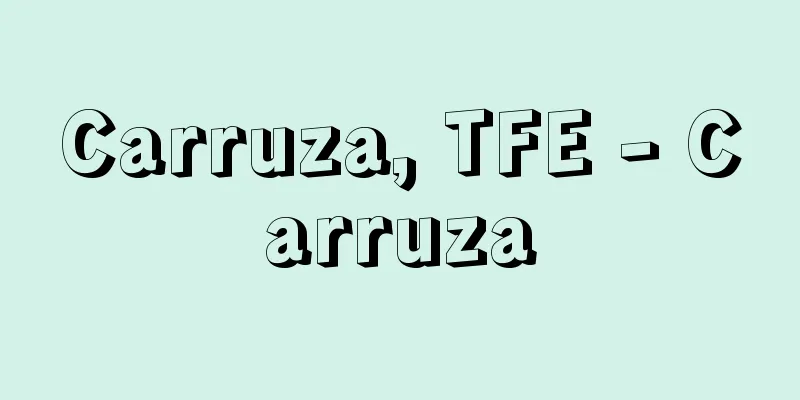Tengunishi (English spelling) false fusus

|
A gastropod snail of the family Acanthidae in the class Gastropoda of the phylum Mollusca. It inhabits sandy bottoms at depths of 10 to 50 meters south of the Boso Peninsula. It is 19 cm high and 8.5 cm in diameter, and is spindle-shaped, somewhat thick, and robust. The spiral spire is conical and has eight stories, and the body layer occupies most of the shell, tapering downwards. There are 10 to 15 nodules on the shoulder of the body layer. Each spiral layer also usually has a strong shoulder angle and 7 to 9 slightly sharp nodules. There are also many thin spiral ribs all over the surface. The shell is pale pink, and is covered with a thick, yellowish brown, velvety shell skin. The shell opening is pale pink and long, tapering downwards to form a wide water canal groove. The outer lip forms a horn at the shoulder. The operculum is long, ovate, leathery, and blackish brown, and the nucleus is at the tapered lower end. They lay eggs in May and June, and the egg sacs are yellow, leathery, fan-shaped, and about 10 mm high, laid in rows on rocks or other surfaces. The eggs develop inside the sacs until they become juvenile shellfish, and then emerge through a small, round exit hole. The egg sacs are called sea nightshade, dyed, and sold at beaches and night stalls as toys that can be played with the mouth. The shells are used in shell crafts, and the meat is edible. [Takashi Okutani] The shell is spindle-shaped and light pink. There is a sharp tubercle on the shoulder of the spiral layer. It lives on sandy bottoms at depths of 10 to 50 meters south of the Boso Peninsula. © Underwater Fort Enterprise, Isamu Soyama "> Tengunishi (ecology) They lay fan-shaped egg sacs called sea nightshades on rocks. © Underwater Fort Enterprise, Isamu Soyama "> Spawning of the Tengu-nisi (biology) Source: Shogakukan Encyclopedia Nipponica About Encyclopedia Nipponica Information | Legend |
|
軟体動物門腹足綱テングニシ科の巻き貝。房総半島以南の水深10~50メートルの砂底にすむ。殻高19センチメートル、殻径8.5センチメートルに達し、殻は紡錘形でやや厚質堅固である。螺塔(らとう)は円錐(えんすい)形で8階、体層は殻全体の大部分を占め、下方へ細く狭くなる。体層の肩角の結節瘤(りゅう)は10~15ある。各螺層も普通は強い肩角があって、7~9の多少とがった結節瘤をもつ。また、全面に多数の細い螺肋(らろく)がある。殻は淡紅色で、表面に黄褐色のビロード状の厚い殻皮をかぶる。殻口は淡紅色で長く、下方へ細まり広く開いた水管溝となる。外唇は肩部で角をつくる。蓋(ふた)は長卵形の革質で黒褐色、核は細まった下端にある。5~6月に産卵し、卵嚢(らんのう)は黄色い革質の軍配形、高さ約10ミリメートルで、列状に並べて岩などに産み付けられる。卵はこの中で幼貝になるまで育ち、小さく丸い脱出口からはい出る。卵嚢はウミホオズキとよばれ染色されて、口で鳴らす玩具(がんぐ)として海水浴場や夜店などで売られている。殻は貝細工に利用され、肉は食用になる。 [奥谷喬司] 殻は紡錘形で淡紅色。螺層の肩角にとがった結節瘤をもつ。房総半島以南の水深10~50mの砂底にすむ©水中フォート・エンタープライズ 楚山いさむ"> テングニシ(生態) 団扇状のウミホオズキとよばれる袋状卵嚢を岩などに産み付ける©水中フォート・エンタープライズ 楚山いさむ"> テングニシの産卵(生態) 出典 小学館 日本大百科全書(ニッポニカ)日本大百科全書(ニッポニカ)について 情報 | 凡例 |
Recommend
detector
…Generally, a device used to detect minute voltag...
Kawanakajima
Located about 5km south of Nagano city, this area...
Hot weather concreting
…It is best to use moderate-heat Portland cement ...
Manda Pond - Manda Pond
This pond was located in Ibaraki County, Kawachi P...
Fremantle
…It has an international airport and is connected...
Khovd - Khovd (English spelling)
The capital of Khovd Prefecture in western Mongol...
River and Sea Collection
A commentary on The Tale of Genji written by Yots...
Void
In physics, it is used in two ways: (1) Atomic va...
Interview - Mensetu
〘noun〙① To meet face to face. Also, to call in app...
corpuscles
…Boyle, the founder of modern chemistry, did not ...
Fixed-term license
〘 noun 〙① To be permanently exempt from taxation. ...
Friendship - Yuai
〘 noun 〙 (adjective verb) The closeness between br...
Capitania General (English spelling) Capitania General
The viceroyalty, the highest administrative divis...
Aeolus sound - Aeolus sound
The sound made when a strong wind blows against a...
Bond, J.
…An international adventure series starring James...









![Flat [village] - Taira](/upload/images/67cc1b44abe3c.webp)